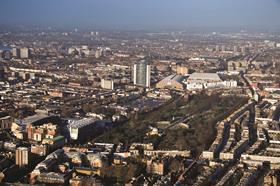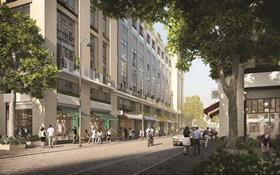Plans to redevelop 77 acres of prime real estate in Earls Court - entailing the demolition of LondonŌĆÖs landmark exhibition centre - have become mired in political wrangling. But is there really any doubt as to how it will end?
It has seen some of the most famous performances in British rock history. But on 13 December, indie band Bombay Bicycle Club look set to be the final booking at Earls Court.
Following that eveningŌĆÖs performance, the art deco venue is due to be readied for demolition, clearing the way for LondonŌĆÖs largest development project. However, the future of developer Capital and CountiesŌĆÖ (Capco) wider ┬Ż8bn plan to transform an entire west London neighbourhood has looked uncertain ever since the council that controls the bulk of the site changed hands in MayŌĆÖs local elections.
In a surprise result, the Conservatives were unseated by the Labour opposition, which had pledged in its manifesto to put the brakes on a swathe of projects across the borough, including the Earls Court scheme. Labour promised to immediately review and renegotiate the schemes, while halting the use of the councilŌĆÖs compulsorily purchase powers which would be needed to bring forward the development.
So, now that the dust has settled on LabourŌĆÖs victory, what does the future look like for one of the capitalŌĆÖs biggest developments? Can the party really stop it from going ahead?

How we got here
The change of council control matters because the regeneration plan was the brainchild of the Tory administration and its ex-leader Stephen Greenhalgh.
The Cambridge University graduate made his name in Conservative circles during the run-up to the last general election with a pamphlet calling for a radical overhaul of housing and planning, which influenced coalition government policy.
West Kensington and Gibbs Green, an island of social housing sandwiched between some of the UKŌĆÖs richest neighbourhoods, became a test tube for one of the pamphletŌĆÖs proposals - to break up council estates. London has seen a number of estate regeneration projects over the past decade and a half, such as Lend LeaseŌĆÖs regeneration of the Elephant and Castle Heygate Estate. But GreenhalghŌĆÖs involvement stoked controversy, while the scale and location set HammersmithŌĆÖs project apart - the site covers 77 acres of the worldŌĆÖs most valuable real estate. In addition, just a fifth of the housing in the new scheme is social rented units, half of which will be allocated to residents of the existing 750 council homes.
The council had originally just wanted to redevelop the 22-acre council estates. But by selecting Capco as preferred developer, Hammersmith was able to unite its own land holding with the sprawling site of the two exhibition centres that its new partner had acquired in 2007 with a view to redevelopment. Sealing a joint venture with Transport for London to build over a tube depot, which juts between the estates and the exhibition centres, was the final piece of the jigsaw.
Capco commissioned award-winning architect Sir Terry Farrell to draw up a masterplan for the entire site, based around four new ŌĆ£villagesŌĆØ (see box).
However, residents of the West Kensington and Gibbs Green estates set up a campaign to resist the councilŌĆÖs demolition plan, roping in veteran housing activist Jonathan Rosenberg who had helped to expose the ŌĆ£homes for votesŌĆØ scandal in nearby Westminster during the early 1990s.
Despite this grassroots opposition, Capco was able to secure the bulk of the consents (see timeline) it required to carry out the development, which straddles two London boroughs.
Kensington and Chelsea council has granted full planning permission for the part of the site covering the exhibition centres, which it has jurisdiction over. But on the Hammersmith side of the border, the developers had only got as far as securing outline consent for the redevelopment by 22 May, when the Conservatives lost control of the council.
The impact of the new regime so far
Rosenberg says: ŌĆ£Capco are at a disadvantage in a way they werenŌĆÖt before where the council was falling over itself to work with them. This scheme was driven by all the powers that the council had.ŌĆØ
The new administration implemented its manifesto commitment to establish a contracts unit to review its agreements with developers, which is being overseen by newly elected Labour councillor Guy Vincent, former managing partner at City law firm Bircham Dyson Bell. However, HammersmithŌĆÖs Labour politicians have discovered that while it is easy to make manifesto commitments, it is more difficult to implement them. And the authority is tight-lipped about how it will do it, holding to its well-worn line that the Earls Court development is under review.
Tory councillor Nick Botterill, who replaced Greenhalgh as council leader before losing the post in MayŌĆÖs election, says the boroughŌĆÖs town hall has been in ŌĆ£chaosŌĆØ since then. ŌĆ£They have a naive view that they can have a great big public meeting and decide what theyŌĆÖre going to build. The reality is that they canŌĆÖt do these things that they want to do.ŌĆØ
Capco investment director Gary Yardley insists he is ŌĆ£not worriedŌĆØ about the new council leader, Steve Cowan, who he says he is due to meet soon. ŌĆ£We are looking forward to working with them, like we worked with the past administration. This is going to take 15 to 20 years to develop. Whoever is in charge politically, whoever is in charge at Capco, there will be changes over time.ŌĆØ
And he doesnŌĆÖt see why Hammersmith would want to stop the development. ŌĆ£ItŌĆÖs a once-in-a lifetime opportunity for everybody concerned, so I think it will go ahead.ŌĆØ
Since the new administration came into power Hammersmith and FulhamŌĆÖs planning committee has granted detailed planning permission for the relatively uncontroversial first phase of the development on a former car park adjacent to the main scheme. And while Capco is prepared to exercise its right to appeal if the council doesnŌĆÖt play ball, Yardley doesnŌĆÖt believe this will be necessary. ŌĆ£We are a long way from that - at Capco, we have never gone through an appeal because we have never needed to.ŌĆØ

A question of cash
The main reason why the council is keeping its head low is the 800-page conditional land sale (CLS) agreement for the estates, which the previous administration signed with Capco. Under the terms of the agreement, Capco has agreed to pay Hammersmith ┬Ż105m for the estates, and committed to rehouse all the tenants within the envelope of the new development. The council has already received around ┬Ż30m and faces a penalty of up to ┬Ż10m if it exits the deal.
While local Labour MP Andy Slaughter believes the CLS was ŌĆ£catastrophicŌĆØ for HammersmithŌĆÖs council tax payers, he acknowledges the cash-strapped local authority canŌĆÖt afford to waste money on wriggling out of the deal. ŌĆ£It canŌĆÖt ignore the law and it canŌĆÖt take inappropriate risks with taxpayersŌĆÖ money.ŌĆØ
Another potential spanner in the works for Capco is a bid by campaigners to take over ownership of their homes. A residents meeting voted last month to serve a right to transfer notice on the council, using rarely exercised powers. Yardley dismisses the transfer bid as a red herring on the grounds that the land under the estates has been sold to Capco under the CLS.
And the scheme is already starting to shape up on the ground, he adds. Piling machines can be glimpsed above the hoardings on the 237-home first phase, known as Lillie Square, where the Paul Davis and Partners-designed scheme is already selling well.
Yardley insists the demolition of the next phase - the Earls Court centres - will begin in winter even though Capco still needs to secure reserved matters consent for the work from Kensington. ŌĆ£The train has left the station,ŌĆØ he says.
Capco has also secured track permission over Christmas from Network Rail and Transport for London to encase the lines that run through the site. ŌĆ£It takes so long to get track possession from Network Rail that they canŌĆÖt pass up this opportunity,ŌĆØ says Botterill. ŌĆ£Whether itŌĆÖs outside bodies or reality is dawning on them, they [Hammersmith] are being pushed into doing what we were expecting to do.ŌĆØ
Heading for negotiation?
Nevertheless, Slaughter believes that the scheme will not go ahead in its current shape, but in a much more piecemeal fashion.
ŌĆ£The whole thing is beginning to unravel,ŌĆØ he says. ŌĆ£Capco will have to do a deal because I canŌĆÖt think how you can evict 2,000 people and demolish their homes. If you look at whatŌĆÖs happened with Heathrow Terminal 2 and HS2 which are major national infrastructure projects, they have had to back down on the demolition of large numbers of homes.
ŌĆ£ItŌĆÖs a massive site but theyŌĆÖve always had an eye to developing it in three distinct tranches.ŌĆØ
Yardley insists that ŌĆ£the whole thing is moving forward,ŌĆØ but hints that Capco may negotiate on affordable housing, one of the new administrationŌĆÖs key priorities. The schemeŌĆÖs one-fifth proportion of social housing is far below the level Labour will be comfortable with.
Yardley says: ŌĆ£We will work with the council on improving the scheme, which could be an additional area of affordable housing. IŌĆÖm sure we will have that debate.ŌĆØ
The curtain may be coming down on Earls Court as a concert venue, but this regeneration show looks set to run and run.

Earls Court timeline
2007
Capco buys half share in Earls Court exhibition centres
June 2009
Hammersmith council unveils its Decent Neighbourhood strategy, including plans for the transformation of the West Kensington and Gibbs Green estates
January 2010
Capco announces mixed-use redevelopment plans of the Earls Court centres
March 2011
Farrell and Partners publishes Capco-commissioned masterplan of Earls Court
February 2012
Hammersmith approves first phase of CapcoŌĆÖs scheme on the Earls Court car park
September 2012
Hammersmith grants outline consent for the parts of the scheme within its borders
January 2013
Hammersmith and Capco sign conditional land sale agreement
August 2013
Eric Pickles says no public inquiry is needed for Earls Court
October 2013
High Court rejects residentsŌĆÖ application for a judicial review of Earls Court scheme
November 2013
Hammersmith and Kensington councils sign ┬Ż452m section 106 agreement with Capco
May 2014
Labour wins control of Hammersmith council
June 2014
New council leader Stephen Cowan says Earls Court scheme will be reviewed
View from the ground
It takes less than five minutes to walk from the Gibbs Green estate to CapcoŌĆÖs marketing suite. But they feel like different worlds, writes David Blackman.
A bowler-hatted gentleman with an Eastern European accent ushers me into the edgily sophisticated suite that is showcasing the homes at Lillie Square - the first phase of the wider Earls Court development.
The books on the shelves range from the comic novels of PG Wodehouse to the art-porn of Helmut Newton, interspersed with the odd Russian language book, suggesting one of CapcoŌĆÖs target markets.
ItŌĆÖs a far cry from the streets of the Gibbs Green and West Kensington estates, which have been lined up for demolition to make way for the main project.
Hammersmith and Fulham councilŌĆÖs previous Conservative administration painted a picture of social decay on the estate, where rates of unemployment and incapacity are nearly twice the average across the borough.
True, there are a few elderly West Indian men toasting the blistering heat with cans of Special Brew. But the odd Audi and BMW, safely parked in the lots between the blocks, suggests that somebody is making a decent living on the estate.
While Gibbs Green contains a number of drab 1970s multi-storey blocks, its heart is made up of low-rise houses and maisonettes and medium-rise, early 1960s blocks. Once bulldozed, these homes will release sites that can be turned into higher density development.
It is these, plus the land underneath the sprawling Earls Court exhibition centres, that will enable developer Capco to increase by tenfold the amount of housing across the masterplan area to 7,500 units.
But tenant Harold Greatwood, proudly sporting a West Kensington and Gibbs Green Community Homes badge, is clearly aghast at the plans to tear up the neighbourhood where he has lived for the past 20 years. The grandfather, who tried to take Hammersmith to judicial review over its regeneration plans, proudly points to the estateŌĆÖs well-maintained communal planting and recreational areas. ŌĆ£Have you ever seen another London estate quite like this? ItŌĆÖs not dysfunctional.ŌĆØ
He argues the estate is not in a poor state of repair, the tower blocks having been renovated to the last Labour governmentŌĆÖs decent homes standard within the past five years.
ŌĆ£ItŌĆÖs never been about these buildings having to be demolished because they are in a bad state of repair,ŌĆØ he says.
Greatwood adds that he and a neighbour on the floor below have made a pact to barricade themselves in. But he acknowledges that, due to the contracts entered into by the former Conservative administration, the Labour-controlled council is stuck between a rock and a hard place. ŌĆ£TheyŌĆÖre either going to become heroes or villains - thereŌĆÖs no middle way.ŌĆØ
Earls Court: vital statistics
- 7,500 new homes, including 1,500 affordable dwellings
- Half of new affordable homes to replace existing 750 council homes and half intermediate, affordable units
- 41 acres of green space, including garden squares, communal gardens and a new 5-acre park
- New east-west high street and north-south main road, improving links within the site and with surrounding neighbourhoods
- New entrance and tunnel to Earls Court tube station, together with improvements to West Brompton and West Kensington stations
- Four new ŌĆ£urban villagesŌĆØ at Earls Court, North End, West Kensington and West Brompton
- Improved local amenities including new primary school, community centre, leisure centre, health centre and cultural space



























No comments yet